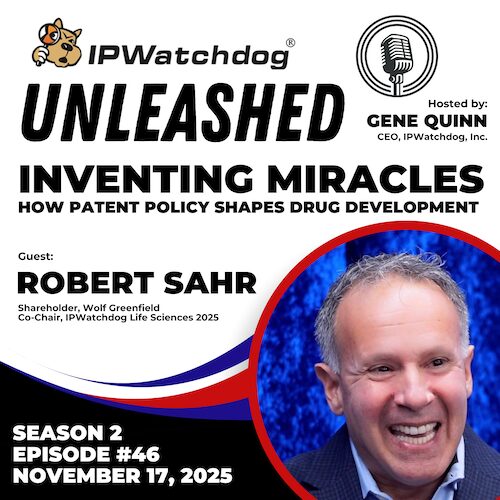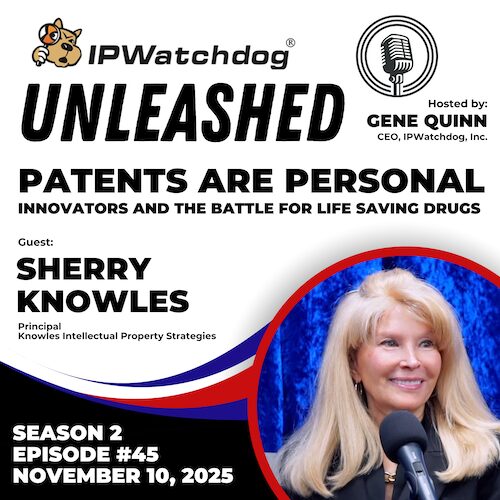“Director Squires has proven to be a friend of inventors, and all of us should support and help him further refine his proposed new rules to stop serial patent challenges and inventor harassment.”
 I would like to thank U.S. Patent and Trademark Office (USPTO) Director John Squires for his initiative to stop serial patent challenges at the USPTO. It is a disgrace that the USPTO and our laws allow such blatant harassment and abuse of process. Squires’ vision is absolutely correct that a patent challenger should have a SINGLE opportunity to challenge a patent in a SINGLE proceeding in a SINGLE venue (a court or the USPTO/Patent Trial and Appeal Board [PTAB], but not both).
I would like to thank U.S. Patent and Trademark Office (USPTO) Director John Squires for his initiative to stop serial patent challenges at the USPTO. It is a disgrace that the USPTO and our laws allow such blatant harassment and abuse of process. Squires’ vision is absolutely correct that a patent challenger should have a SINGLE opportunity to challenge a patent in a SINGLE proceeding in a SINGLE venue (a court or the USPTO/Patent Trial and Appeal Board [PTAB], but not both).
However, the following are loopholes in the proposed new rules that serial patent challengers will undoubtedly exploit if left open:
- First and largest loophole is the institution of ex parte reexaminations (EPRs) (and possibly other USPTO/PTAB proceedings) after past inter partes review (IPRs) or during currently pending IPRs for the same patents that the new rules do not address at all. The proposed rules focus on institutions of future IPRs and EPRs (based on the new IPR stipulation rule), but the new rules should also apply to the institutions of EPRs for patents that have past or pending IPRs to prevent patent challengers from using EPRs where the legal issues are already adjudicated in past IPRs or will be adjudicated in pending IPRs. If the new rules are not upgraded to apply to these “transitional” EPRs, serial patent challenges that the Office is trying to immediately prevent will be allowed to continue for at least another 1.5 years by allowing institutions of these “transitional” EPRs (“transitional” because the EPR institution decision will be after the new rules become effective, but the prior IPR was instituted before the new rules became effective).
Thus, the new rules should state that if there is a past or currently pending IPR, there was an opportunity to make the best arguments with the best prior art, and the same or another patent challenger’s EPR should be denied since the legal issues have been or will be decided in the past or pending IPR.
In addition to the importance of the new rules applying to EPRs, timing of when the new rules apply to EPRs is also very important. Serial patent challengers will accelerate their EPR fillings in expectation of the new rules and many inventors are expecting frontloaded EPRs before the rules become effective. Thus, in order for the new rules to actually prevent serial patent challenges and close this “transitional” EPR loophole, the new rules should apply to all EPR institution decisions after the new rules become effective – i.e. the new rules should apply to EPRs based on the EPR institution decision date (not EPR filing date) being after the new rules’ effective date, which is both logical, reasonable (certainly much more reasonable than allowing serial patent challenges and inventor harassment to continue), and accomplishes the goal of the new rules.
- The second loophole is in “(f) Parallel Litigation — Inter partes review shall not be instituted or maintained if, more likely than not, any of the following will occur, …, before the due date for the final written decision pursuant to 35 U.S.C. 316(a)(11): (1) … A district court trial …; (2) … an initial or final determination of the U.S. International Trade Commission …; or (3) … issuance of a final written decision by the Board under 35 U.S.C. 318(a) or 328(a).
In the spirit of the Director’s vision that a patent challenger should have a SINGLE opportunity to challenge a patent in a SINGLE proceeding in a SINGLE venue, IPR, EPR, or other relevant USPTO proceedings should be denied if there is any other parallel proceeding in any other venue that will adjudicate all or most legal issues in a patent. Paragraph (f)’s vague timing of the final written decision and whether it is more likely than not to occur before a parallel proceeding’s trial, initial or final determination, or final written decision is a loophole that will undoubtedly be exploited by serial patent challengers. The issue here is simple: the Office should not want a patent challenger to get two opportunities since that is a serial challenge and harassment, which is what the new rules are trying to prevent. Specifically, for example, if there is a pending district court case, all IPRs, EPRs, or other relevant proceedings for the same patents should be denied because the patent challenger will have its single opportunity to challenge the patents in district court.
- The third loophole is in “(g) institution in extraordinary circumstances” that would enable serial patent challengers and future pro-infringer anti-inventor USPTO directors to allow serial patent challenges canceling the intended effects of the new rules. Thus, please further tighten the final rules to leave no opportunity for patent challengers or future USPTO directors to abuse the system.
Have Your Say
All patent stakeholders are urged to submit the points above with any of their own edits to the USPTO by December 2, 2025 (the original deadline was November 17, 2025, but was extended 15 days). Director Squires has proven to be a friend of inventors, and all of us should support and help him further refine his proposed new rules to stop serial patent challenges and inventor harassment. His proposed new rules directly increase the value of our clients’ patents because they remove the constant threat of serial patent challenges.

![[IPWatchdog Logo]](https://ipwatchdog.com/wp-content/themes/IPWatchdog%20-%202023/assets/images/temp/logo-small@2x.png)

![[Advertisement]](https://ipwatchdog.com/wp-content/uploads/2025/11/Junior-AI-Nov-25-2025-sidebar-CLE-700x500-1.jpg)
![[Advertisement]](https://ipwatchdog.com/wp-content/uploads/2025/11/IP-Author-Dec-2-2025-sidebar-700x500-1.jpg)
![[Advertisement]](https://ipwatchdog.com/wp-content/uploads/2025/11/Juristat-Ad-Firm-Cost-Management-Nov-18-Dec-31-2025-Animated-Varsity-Ad-final.gif)
![[Advertisement]](https://ipwatchdog.com/wp-content/uploads/2025/11/PTAB-Masters-2026-sidebar-early-bird-700x500-1.jpg)







![[Advertisement]](https://ipwatchdog.com/wp-content/uploads/2021/12/WEBINAR-336-x-280-px.png)
![[Advertisement]](https://ipwatchdog.com/wp-content/uploads/2021/12/Ad-4-The-Invent-Patent-System™.png)



Join the Discussion
No comments yet. Add my comment.
Add Comment